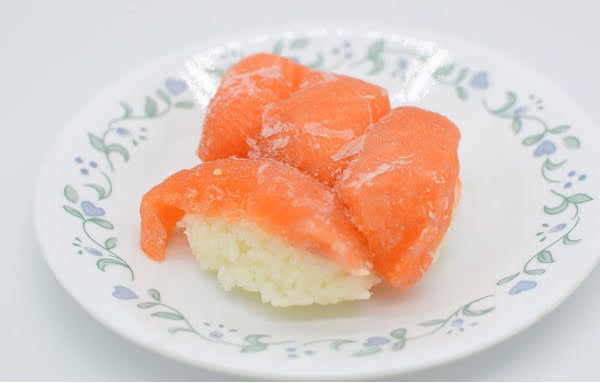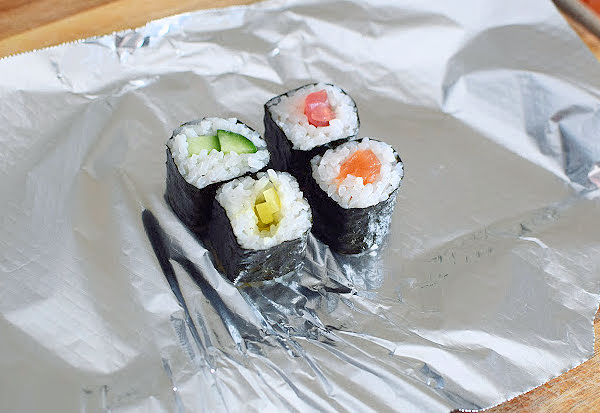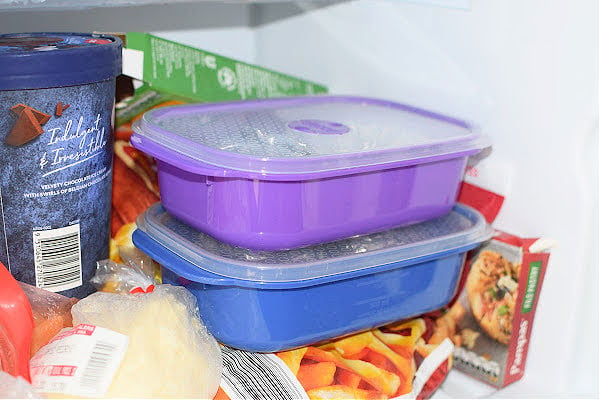Ordering the right amount of sushi can be a challenge, even for people who buy it often. This leads to the question if you’ve got leftovers, can you freeze sushi?
Instead of researching the answers online, we forked out the cash and bought a range of sushi, then froze it to get the real answers. The results helped us create this ultimate guide to sushi storage – we hope it answers all your questions.
Is it okay to freeze sushi?
From a food safety view, it is safe to freeze sushi for up to 3 months. Our testing found the quality of sashimi was excellent once thawed. The rice component of California rolls, maki rolls, inari, and nigiri was dry and unpleasant once defrosted, even when frozen for just a few days.
| Type of sushi | Quality after defrosting | Would we freeze again? |
|---|---|---|
| Sashimi | 9/10 | Yes |
| Inari | 6/10 | No |
| Nigiri | 5/10 | No |
| California roll | 4/10 | No |
| Maki roll | 3/10 | No |
Sashimi: The winner in this experiment was raw fish frozen on its own. Once thawed, the salmon and tuna maintained their color, texture, and flavor. No one would know it wasn’t fresh.
The FDA requires fish that is served raw to be frozen first to kill off unwanted parasites. This backs up our findings that fish is still delicious after storing frozen.
Sushi with rice: Any sushi that contains rice is not suitable for freezing. It turns dry and crumbly, the opposite of what you expect from fresh sushi rice.
Interestingly, we found that nori paper holds up better than expected. You could freeze it if you’re in a pinch, but it’s best to refrigerate if possible.
Other fillings used in sushi, like cucumber and avocado lost some of their color and texture. Sauces like mayonnaise didn’t have the same delicious, silky consistency once thawed.

Sushi rice turns crumbly and dry after freezing.
How long can I store sushi?
Sushi can be stored at room temperature for a maximum of 2 hours before the risk of foodborne illness increases significantly. After this time, raw sushi can be refrigerated for 1-2 days before it should be discarded. Cooked sushi can be kept in the fridge for up to 2 days, but keep in mind the rice will lose its freshness.
How to freeze homemade sushi
- Individually wrap each piece of room temperature sushi in cling wrap and place them in an airtight container.
- Label the container with current date and type of sushi.
- Place the container at the back of the freezer to minimize temperature fluctuation.

Wrap sushi in small groups or individually before freezing.
Tips for freezing sushi
- Wrapping each sushi separately stops them from sticking together.
- If you’ve got sushi that’s been out of the fridge for over 2 hours toss it out.
- Freezing won’t kill off all the bugs.
- Try to avoid freezing sushi that’s smothered in condiments like mayonnaise, wasabi, or soy sauce. The texture won’t be great once defrosted.
How to defrost frozen sushi
The safest way to thaw sushi is to transfer them to the fridge and leave overnight. Defrosting them on the benchtop is quicker, but they may also thaw unevenly, increasing the chance of bacteria growth.
Another popular method of thawing sushi is to place it in a ziplock bag and submerge in a bowl of warm water. Within 30 minutes the sushi should be ready to eat.
Although some people suggest defrosting in the microwave, we recommend against it. Hot spots can result in dry sections of inedible sushi. However, once it's thawed, you can help to bring the sushi back to life using heat. Check out our handy guide to reheating sushi.

Airtight containers keep oxygen and odors away from your food.
Commonly asked questions
Can you freeze sushi rice?
Sushi rice is best eaten on the day it is cooked as it turns dry and crumbly once defrosted. If you must freeze it, allow the rice to cool, then transfer to ziplock bags and seal. Label with the current date and store frozen for up to 3 months.
Keep in mind that although we don't recommend freezing sushi rice, it is okay to freeze cooked rice like basmati and jasmine.
How can I tell if sushi has gone bad?
If you’ve left sushi out of the fridge longer than two hours then toss it in the bin to avoid unwanted stomach bugs or worse. Foodborne illnesses like listeria won’t provide any signs that the food is off, you’ll just get sick. Sushi is a high-risk type of food, even the rice component, so it’s best to use extra caution.
What’s the best way to store sushi refrigerated?
To store sushi in the fridge, wrap it in cling wrap, ensuring no air can get in. Next, place the sushi in an airtight container and seal, before refrigerating. If you have a vacuum sealer then this is a great option for keeping your food fresh.
Some online sources recommend microwaving sushi that contains raw fish until cooked, then refrigerating it. The idea here is that cooked fish can be stored for an extra couple of days. However, we tried this and found the fish was rubbery and not cooked evenly. In our opinion, it’s better to eat the sushi within one day or just toss it out.
Worth reading:
How to make homemade sushi rolls.
What can I use as a substitute for unagi sauce?

Sushi is best eaten fresh.
Summing up
If you’ve got leftover packs of sashimi, then freezing them makes sense. It’s a food-safe practice according to the FDA and the freezer helps you avoid food waste.
For all types of sushi that include rice, you’re best to refrigerate and eat everything the next day. Frozen rice turns dry once thawed. Ingredients like cucumber and avocado are okay if they’re frozen for less than a week. Longer freezing time dulls their color and their texture begins to turn mushy.
Do you have leftover sushi because you’re dealing with picky eaters? You’ll do well to check out our illustrated guide on what sushi is best for fussy eaters. You may also want to incorporate a mix of other dishes with your sushi for more variety. Get the essential list of what to serve with sushi here.

Leave a Reply